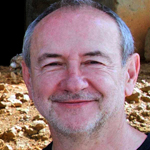Rocky shallow water. The confluence of the rivers Kumaradhara and Netravati, near the city of Appinanagadi, Karnataka, India
3rd place in Biotope Aquarium Design Contest 2018
![]() Russia. Sergey Lobanov
Russia. Sergey Lobanov

Volume: 750 L
Dimensions: 150х100х50 cm
List of fishes: Etroplus canarensis
List of plants: N/A
Description of decorations: In my aquarium, I used materials taken from nature in form, texture, and color similar to those presented in the natural biotope seen in the video. These were rounded river stones of various sizes, taken from the fast Siberian river; roots and branches, mainly poplar and willow; the fallen leaves of willow and fruit trees, the foliage, of course, is temporary, decaying, within a couple of weeks; dark sand from the local reservoir was used as a ground; volcanic lava is used as a substrate for making the ground level higher.
Description of equipment: Sump 380 L, of which 150 L is filter material: mechanical filtration: coarse and fine sponges; biological filtration: BioBalls No name and Eheim Substrat Pro; lifting pump: Eheim 1260, 2300 l/h, additionally two UniStar Power Head submersible mechanical filters with a large pore sponge, 2000 l/h, heater: Eheim Jager 300W, lighting: Led 10 W 6500 K x 4 pcs.
Water parameters: Temperature is 25°С, рН is 7.0, gH is 4.0.
INFORMATION ABOUT BIOTOPE
Description of the area surrounding the biotope: The confluence of the Kumaradhara and Netravati rivers takes place near the town of Appinangadi, subsequently the Netravati river flows into the Arabian Sea. Netravati originates from the Kudremukh mountain range, which is part of the Western Ghats. This river is the main source of water in Bantval and Mangalore. The Kumaradhara River also originates from the Western Ghats, the Subramania region. During the monsoon rains, the water level rises significantly, floods occur periodically, the last one occurred in 1974.
Description of the underwater landscape of the biotope: The underwater landscape of the biotope consists of a large number of driftwood, tree roots, alluvial rocks, different fractions from large rounded boulders to small pebbles and litter from fallen leaves. The main substrate is dark brown silted sand.
Description of the parameters of the habitat: Biotope tends to change throughout the year. In the dry season, the water is completely clear, rich in dissolved oxygen, and slowly flows over the stony and sandy substrate. In the period of monsoon rains, the depth and flow rate increase significantly, the temperature decreases (to 20–23°C) and the turbidity of water increases significantly. pH is 6.5-7.5, GH is 2, KH is 2, TDS is 40, temperature in the dry season is up to 32°С.
List of fishes and invertebrates occurring in the nature biotope: Nemacheilus stigmofasciatus, Nemacheilus triagularis, Garra mullya, Barilius canarensis, Pristolepis marginata.
List of plants found in the nature biotope: In this biotope, described by me, there are no aquatic plants, surface plants may be found in flooded areas.
Threats to the ecology: The environmental problems of the biotope of the Kumaradhara and Netravati rivers are part of the global lack of interaction between society and nature. Industrial and urban air pollution in general, the source of which is industrial production and utilities, affects the rivers Kumaradhara and Netravati. Complex disturbance of land caused by the extraction of mineral resources and the irrational and depleting farming. Acidification, soil salinization and loss of nutrients in soils caused by irrigated agriculture and their depletion. As a result, the pollution of the rivers Kumaradhara and Netravati. Severe pollution of surface waters, reduction of river current due to sand extraction, the problem of water erosion. A lot of mini-hydropower plants have been created on these rivers, and a huge number of projects are still under development, which leads to the fragmentation of hydrobiont populations. There is a project to change the channel of the Netravati river, turning the river path to irrigate the land above the western ghats. Changes in the river bed can lead to unforeseen environmental disasters. All these problems pose a tremendous threat to the biotope, a huge number of aquatic organisms are threatened, including the endemic of the Kumaradhara and Netravati rivers: Etroplus canarensis.
Sources of information:
https://ru.wikipedia.org/wiki/
https://en.wikipedia.org/wiki/
https://en.wikipedia.org/wiki/
https://en.wikipedia.org/wiki/
https://en.wikipedia.org/wiki/
http://www.seriouslyfish.com/
http://wgbis.ces.iisc.ernet.
http://kaknado.info/home/%D0%
Comments of the members of the jury of Biotope Aquarium Design Contest 2018

This design is really natural. I just want you to do a little more fascinating design, because your tank sizes are good for that. A design that uses smaller materials to increase the front-to-back perspective could have made this tank look much better. I would like to see much rock for rocky shallows. The rocks are disappeared between the driftwoods. However this tank is the one of most natural biotope in this competition. I liked harmony and colour contrast of this biotope. Your species look very healthy. Congrats.

It is a simply perfect and natural looking species tank. The setting is not only beautiful, it is indeed looking like a part of a river near the shoreline, with a fantastic arrangement of the roots, with the leaf litter in between and some bigger stones in the open water zone. Also the light is perfect. It is a kind of a masterpiece.

This work is worth mentioning. It is clear that the author worked on it for a long time. There is clearly shown coastal zone with tree roots and growing depth, where the bottom is covered with more and more stones, starting with small pebbles.
